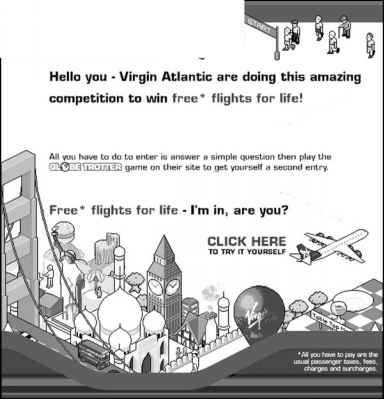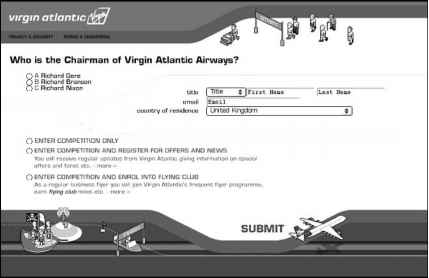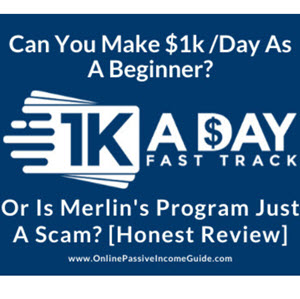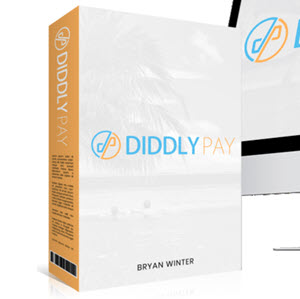Virgin Atlantic Fly Free For Life
The campaign
To celebrate the launch of Virgin Atlantic's new web site, a viral campaign was launched offering one customer the chance to Fly Free For Life (paying applicable passenger taxes). A competition and game were used to encourage people to visit a microsite and provide their e-mail address. This campaign was promoted via cold e-
virgin atlantic jiff/
virgin atlantic jiff/

- Figure 1.5 E-mail creative for the Virgin Atlantic Fly Free For Life campaign
mails to bought-in lists (Figure 1.5), banners on various sites, the flying club newsletter, a radio campaign and poster site driving traffic to a specially built microsite. To maximise exposure, it was expected that the campaign would take off virally (i.e. the game would be forwarded by e-mail to friends to play, and they would forward it on, etc.). The main objective of the campaign was to sign up customers to the site-registered base, to receive e-mail alerts on Virgin Atlantic offers and news.
The microsite
Once at the microsite (Figure 1.6), customers had to answer a simple question (Who is the chairman of Virgin Atlantic Airways?) to gain entry into the competition. The microsite offered customers the choice of three types of entry:
• enter the competition only (for people who may already have joined up to the flying club, were already site registered or who were just competition 'junkies')
• enter the competition and site register (to receive e-mail alerts on special offers and news)
• enter the competition and enrol in the flying club.

- Figure 1.6 Landing page competition creative for the Virgin Atlantic Fly Free For Life campaign
To gain a further entry into the competition, entrants also had the opportunity to play the interactive game on the microsite.
This game was called 'Globetrotter' and was based on visitors navigating their way around the world (depicted by icons of Virgin's network, e.g. Statue of Liberty, palm trees) within a time limit and being chased by a pack of 'wannabe mates' (who have come out of the woodwork to go on holiday with you now you have won this fantastic prize!). If the players bumped into anything they slowed down and their mates had a chance of catching them up, therefore sending them back to the beginning.
The ability to send the game to a friend was present throughout. If the game was forwarded to a friend, it contained a score to beat (time taken to complete/fail game), to provide a challenge aspect. Once the game was completed users were given the option of playing again and prompted to refer friends. Users were also prompted to visit the new web site.
For each friend who went on to enter the competition, the original entrant (who forwarded the game in the first place) received another entry into the competition, thereby increasing their chances of winning.
As well as launching in the UK, the campaign launched in the USA, Hong Kong, India and South Africa, offering free flights for life to London. The 'Lovin' London' game was specific to the UK, with icons and landscapes of the UK to navigate through.
E-mail lists
The e-mail lists and the relevant selects used for this campaign were:
TheMutual.net HTML and text 10000 30+, £40k+, have clicked on travel offers
Doubleclick HTML and text 15000 Economy, professional
Claritas HTML and text 15000 Economy travellers, non-European destinations
Guardian newsletter Text 5 x 35 000 Long-haul travellers
Virgin Wines database HTML and text 90000
These lists were selected primarily on the audience being long-haul, leisure economy travellers who had expressed an interest in travel.
Results
The total traffic from all online advertising and all e-mail activity was 241 460 visits.
Delivered 190 523
HTML open rate 82 686 43%
Clickthrough 53 939 31%
Clickthrough from opened e-mails 65%
Pass along (e-mail referrals) 2932 1.53%
Banner advertising delivered 10 296 clickthroughs with an average clickthrough rate of 0.63%.
In addition to e-mail passalongs, the viral contribution of the campaign was successful with, on average, just under one e-mail per visitor being sent from the site to friends to spread the word about the site. It resulted in 200 000 additional e-mails being delivered from the site: the main source of visitors. Clickthrough for opened e-mails was extremely high, averaging around 80%, suggesting that the offer and creative were compelling.
Over 100 000 registrants with e-mail addresses available for future campaigns were achieved, breaking down as follows:
Registration online Globetrotter Lovin' London Total
Competition only 67138 29906 97 044
Site registered 70 508 27 661 98169
Flying club 8891 4763 13 654
Total 208 867
(Case courtesy of Tara Topliff and Naomi Broad at Virgin Atlantic and Glenn Jones at glue London.)
^WiVfiy
18b introduction
REFERENCES
Forrester (2001). E-mail marketing press release, November.
Gartner G2 (2002). Gartner G2 says e-mail marketing campaigns threaten traditional direct mail promotions. Gartner G2 press release, 19 March. NetValue (2002). Record e-mail usage signals last post for letters. Press release, 13 March. NetValue UK (www.netvalue.com).
Clickz (www.clickz.com) has great columns on e-mail marketing, e-mail marketing optimisation and e-mail marketing case studies.
Conversion Marketing objectives spreadsheet (www.weboutcomes.com).
DM News (www.dmnews.com): updates on e-mail campaigns and new practices.
EMMA - E-Mail Marketing Association (www.emmacharter.org), formed in July 2001 to support best practice amongst agencies and clients; charter gives best practice guidelines on e-mail marketing.
Opt-in News (www.optinnews.com): an online magazine focusing on permission-based e-mail marketing. Also has columns similar to ClickZ.
Chapter
E-mail marketing fundamentals

CHAPTER AT A GLANCE Overview
This chapter looks at what the concepts of permission marketing and customer relationship management mean in practice. What does permission marketing mean beyond 'opt-in'? Under what legal constraints do e-mail marketers operate?
Was this article helpful?


